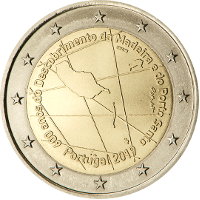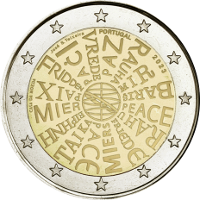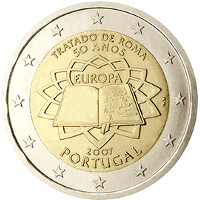 |
 |
C o m m e m o r a t i v e
C o i n s |
||
| Portugal | |||||||
The edge embossing on the Portuguese 2‐Euro‐commemorative coins is : (The edge shows seven forts and five heraldic shields) |
until 2019 : INCM from 2020 : CASA DA MOEDA |
||||||

|
 |
Portugal | Portuguese Presidency of the Council of the European Union | 20001 |  |
Volume : 1,300,000 Date of Issue : 02 Jul. 2007 Designer : Maria Irene Vilar Producer : Portugease mint Imprensa Nacional‐ Casa da Moeda S.A. in Lisbon (Mintmark = "INCM") |
|||||

|
 |
Portugal | 60th anniversary of the Universal Declaration of Human Rights | 20001 |  |
Volume : 1,035,000 Date of Issue : 15 Sep. 2008 Designer : João Duarte ("Esc.J.Duarte" ‐ Escultor = Esc.) Producer : Portugease mint Imprensa Nacional‐ Casa da Moeda S.A. in Lisbon (Mintmark = "INCM") |
|||||

|
 |
Portugal | 10 years of Economic and Monetary Union (EMU) | 20001 |
 |
Volume : 1,285,000 Date of Issue : 05 Feb. 2009 Designer : Georgios Stamatopoulos ("ΓΣ") Producer : Portugease mint Imprensa Nacional‐ Casa da Moeda S.A. in Lisbon (without Mintmark) |
|||||

|
 |
Portugal | Lusophony Games 2009 | 20001 |  |
Volume : 1,285,000 Date of Issue : 09 Jun. 2009 Designer : José Aurélio ("J. AURÉLIO") Producer : Portugease mint Imprensa Nacional‐ Casa da Moeda S.A. in Lisbon (Mintmark = "INCM") |
|||||

|
 |
Portugal | Centenary of the Portuguese Republic | 20001 |  |
Volume : 1,035,000 Date of Issue : 07 Sep. 2010 Designer : José Cândido ("JOSÉ CÂNDIDO") Producer : Portugease mint Imprensa Nacional‐ Casa da Moeda S.A. in Lisbon (Mintmark = "INCM") |
|||||

|
 |
Portugal | 500th birthday of Fernão Mendes Pinto | 20001 |  |
Volume : 520,000 Date of Issue : 15 Sep. 2011 Designer : Isabel Carriço und Fernando Branco ("IC‐FB") Producer : Portugease mint Imprensa Nacional‐ Casa da Moeda S.A. in Lisbon (Mintmark = "INCM") |
|||||

|
 |
Portugal | 10 years Euro‐Currency | 20001 |
 |
Volume : 520,000 Date of Issue : 24 Feb. 2012 Designer : Helmut Andexlinger Producer : Portugease mint Imprensa Nacional‐ Casa da Moeda S.A. in Lisbon (Mintmark = "INCM") |
|||||

|
 |
Portugal | Guimaräes, European Capital of Culture 2012 | 20001 |  |
Volume : 520,000 Date of Issue : 21 Jun. 2012 Designer : José Maria Fernandes Marques ("JOSÉ DE GUIMARÃES") Producer : Portugease mint Imprensa Nacional‐ Casa da Moeda S.A. in Lisbon (Mintmark = "INCM") |
|||||

|
 |
Portugal | 250th anniversary of the Torre dos Clérigos, Porto | 20001 |  |
Volume : 525,000 Date of Issue : 20 Jun. 2013 Designer : Hugo Maciel ("HUGO MACIEL") Producer : Portugease mint Imprensa Nacional‐ Casa da Moeda S.A. in Lisbon (Mintmark = "INCM") |
|||||

|
 |
Portugal | 40th anniversary of the Carnation Revolution | 20001 |  |
Volume : 520,000 Date of Issue : 23 Apr. 2014 Designer : José Teixeira ("JOSÉ TEIXEIRA") Producer : Portugease mint Imprensa Nacional‐ Casa da Moeda S.A. in Lisbon (Mintmark = "INCM") |
|||||

|
 |
Portugal | International Year of Family Farming | 20001 |  |
Volume : 520,000 Date of Issue : 31 Oct. 2014 Designer : Helder Batista ("H.BATISTA") Producer : Portugease mint Imprensa Nacional‐ Casa da Moeda S.A. in Lisbon (Mintmark = "INCM") |
|||||

|
 |
Portugal | 150 years Portuguese Red Cross | 20001 |  |
Volume : 520,000 Date of Issue : 25 Apr. 2015 Designer : António Marinho ("A.M.") Producer : Portugease mint Imprensa Nacional‐ Casa da Moeda S.A. in Lisbon (Mintmark = "INCM") |
|||||

|
 |
Portugal | 500th anniversary of the first contact with Timor | 20001 |  |
Volume : 520,000 Date of Issue : 15 Jul. 2015 Designer : Fernando Fonseca Producer : Portugease mint Imprensa Nacional‐ Casa da Moeda S.A. in Lisbon (Mintmark = "INCM") |
|||||

|
 |
Portugal | 30 years EU‐Flag | 20001 |
 |
Volume : 520,000 Date of Issue : 30 Nov. 2015 Designer : Georgios Stamatopoulos ("ΓΣ") Producer : Portugease mint Imprensa Nacional‐ Casa da Moeda S.A. in Lisbon (Mintmark = "INCM") |
|||||

|
 |
Portugal | Portuguese athletes participation in the Rio 2016 Summer Olympics |
20001 |  |
Volume : 530,000 Date of Issue : 03 May 2016 Designer : Joana Vasconcelos Producer : Portugease mint Imprensa Nacional‐ Casa da Moeda S.A. in Lisbon (Mintmark = "INCM") |
|||||

|
 |
Portugal | 50 years of the first bridge uniting the two riverbanks of the Tagus River | 20001 |  |
Volume : 520,000 Date of Issue : 19 Jul. 2016 Designer : José Aurélio ("JOSÉ AURÉLIO") Producer : Portugease mint Imprensa Nacional‐ Casa da Moeda S.A. in Lisbon (Mintmark = "INCM") |
|||||

|
 |
Portugal | 150 years of Public Security (PSP) | 20001 |  |
Volume : 520,000 Date of Issue : 13 Jul. 2017 Designer : José Maria Fernandes Marques ("JOSÉ DE GUIMARÃES") Producer : Portugease mint Imprensa Nacional‐ Casa da Moeda S.A. in Lisbon (Mintmark = "INCM") |
|||||

|
 |
Portugal | 150th birthday of Raul Brandäos | 20001 |  |
Volume : 520,000 Date of Issue : 21 Nov. 2017 Designer : Luís Felipe De Abreu ("LUÍS FELIPE DE ABREU") Producer : Portugease mint Imprensa Nacional‐ Casa da Moeda S.A. in Lisbon (Mintmark = "INCM") |
|||||

|
 |
Portugal | 250 years since the foundation of the Imprensa Nacional | 20001 |  |
Volume : 450,500 Date of Issue : 22 May 2018 Designer : Eduardo Aires ("Eduardo Aires") Producer : Portugease mint Imprensa Nacional‐ Casa da Moeda S.A. in Lisbon (Mintmark = "INCM") |
|||||

|
 |
Portugal | 250th anniversary of the foundation of Ajuda Botanical Garden | 20001 |  |
Volume : 450,500 Date of Issue : 25 Jul. 2018 Designer : Joao Fazenda ("J. FAZENDA") Producer : Portugease mint Imprensa Nacional‐ Casa da Moeda S.A. in Lisbon (Mintmark = "INCM") |
|||||

|
 |
Portugal | 500th anniversary of Magellan's circumnavigation | 20001 |  |
Volume : 520,000 Date of Issue : 08 May 2019 Designer : Luís Filipe de Abreu ("L.F.ABREU") Producer : Portugease mint Imprensa Nacional‐ Casa da Moeda S.A. in Lisbon (Mintmark = "INCM") |
|||||

|
 |
Portugal | 600th anniversary of the discovery of Madeira and Porto Santos | 20001 |  |
Volume : 520,000 Date of Issue : 06 Jun. 2019 Designer : Júlio Pomar ("POMAR") Producer : Portugease mint Imprensa Nacional‐ Casa da Moeda S.A. in Lisbon (Mintmark = "INCM") |
|||||

|
 |
Portugal | 730th anniversary of the University of Coimbra | 20001 |  |
Volume : 360,000 Date of Issue : 01 Sep. 2020 Designer : José João Brito ("Esc. J. J. BRITO") Producer : Portugease mint Imprensa Nacional‐ Casa da Moeda S.A. in Lisbon (Mintmark = "CASA DA MOEDA") |
|||||

|
 |
Portugal | 75th anniversary of the United Nations | 20001 |  |
Volume : 510,000 Date of Issue : 07 Oct. 2020 Designer : André Letria ("ANDRÉ LETRIA") Producer : Portugease mint Imprensa Nacional‐ Casa da Moeda S.A. in Lisbon (Mintmark = "CASA DA MOEDA") |
|||||

|
 |
Portugal | EU Presidency 2021 | 20001 |  |
Volume : 510,000 Date of Issue : 04 Jan. 2021 Designer : Eduardo Aires ("EDUARDO AIRES") Producer : Portugease mint Imprensa Nacional‐ Casa da Moeda S.A. in Lisbon (Mintmark = "CASA DA MOEDA") |
|||||

|
 |
Portugal | Participation in the Summer Olympics in Tokyo | 20001 |  |
Volume : 510,000 Date of Issue : 18 May 2021 Designer : Francisco Providencia ("F. PROVIDENCIA") Producer : Portugease mint Imprensa Nacional‐ Casa da Moeda S.A. in Lisbon (Mintmark = "CASA DA MOEDA") |
|||||

|
 |
Portugal | 100th anniversary of the first crossing of the South Atlantic by plane | 20001 |  |
Volume : 1,015,000 Date of Issue : 30 Mar. 2022 Designer : José João Brito ("Esc. JJ BRITO") Producer : Portugease mint Imprensa Nacional‐ Casa da Moeda S.A. in Lisbon (Mintmark = "CASA DA MOEDA") |
|||||

|
 |
Portugal | 35th anniversary of the Erasmus Program | 20001 |
 |
Volume : 512,000 Date of Issue : 01 Jul. 2022 Designer : Joaquin Jimenez Producer : Portugease mint Imprensa Nacional‐ Casa da Moeda S.A. in Lisbon (Mintmark = "CASA DA MOEDA") |
|||||

|
 |
Portugal | World Youth Day Lisbon 2023 | 20001 |  |
Volume : 1,015,000 Date of Issue : 19 Jul. 2023 Designer : João Duarte ("JOÃO DUARTE") Producer : Portugease mint Imprensa Nacional‐ Casa da Moeda S.A. in Lisbon (Mintmark = "CASA DA MOEDA") |
|||||

|
 |
Portugal | Peace | 20001 |  |
Volume : 515,000 Date of Issue : 15 Nov. 2023 Designer : José S. Teixeira ("José S. Teixeira") Producer : Portugease mint Imprensa Nacional‐ Casa da Moeda S.A. in Lisbon (Mintmark = "CASA DA MOEDA") |
|||||

|
 |
Portugal | 50th anniversary of the Carnation Revolution of 25 April 1974 | 20003 |  |
Volume : 515,000 Date of Issue : 22 Apr. 2024 Designer : Henrique Cayatte ("Henrique Cayatte") Producer : Portugease mint Imprensa Nacional‐ Casa da Moeda S.A. in Lisbon (Mintmark = "CASA DA MOEDA") |
|||||

|
 |
Portugal | Potugal's participation in the 2024 Olympic Games | 20003 |  |
Volume : 520,000 Date of Issue : 04 Jul. 2024 Designer : Rita Margarida ("RITA MARGARIDA") Producer : Portugease mint Imprensa Nacional‐ Casa da Moeda S.A. in Lisbon (Mintmark = "CASA DA MOEDA") |
|||||
| References : | |||
| 20001 | Images taken with authorisation by the ECB ‐ Mail dated 20.Feb.2020 © "European Central Bank" |
20002 | Not Applicable |
| 20003 | Images taken temporally from the Internet | 20004 | Not Applicable |
 |




